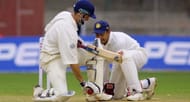
Test cricket, as the name suggests, is the ultimate test of a player's skill, temperament, and endurance. It is the oldest format of the game, with its younger cousins - one-day internationals and T20s - being less than half a century old.
Since the first-ever Test match played between Australia and England in Melbourne in 1877, a total of 12 different teams have played 2387 Test matches amongst themselves. During these 143 years, over 73000 dismissals have been recorded.
A dismissal is so called because it refers to when a player loses his wicket. Under the present laws of the game, a player can be dismissed in 11 different ways. The most common forms of dismissals are bowled, caught by a fielder (which includes the bowler and the wicketkeeper), stumped, leg-before-wicket (LBW), and run out which cumulatively account for over 99% of all dismissals recorded in Test history. Caught by a fieldsman (58%) is the most common form of dismissal.
The other forms of dismissal - hitting the ball twice, handling the ball, obstructing the field, timed out, hit wicket and retired out are extremely rare, cumulatively accounting for less than 1% of all dismissals. On that note, let us have a look at the three rarest forms of dismissals in test cricket:
#3. Handled the ball (7)

"Handled the ball" is the term which describes the intentional usage of a batsman's hand that is not in contact with the bat to touch the ball.
Since Russel Endean of South Africa was adjudged out handling the ball in the second Test between South Africa and England in Cape Town in 1957, there have been 6 different instances of this mode of dismissal in Test cricket to dismiss a player. England's Michael Vaughan is the last player to be out dismissed handling the ball in the third Test between England and India in Bangalore in 2001.
Marylebone Cricket Club (MCC), the official custodians of the game integrated 'handled the ball into the 'obstructing the field' mode of dismissal.
Also see – World Test Championship points table
#2. Retired out (2)

.
Law 25 of the Marylebone Cricket Club defines 'retired out' if a player retires/leaves the field of play without the umpire's permission and does not have the permission of the opposing captain to resume his innings. Such a player may only return to resume his innings with the consent of the opposition captain, in the absence of which the said player is deemed 'retired out'.
Often considered an act of unsportsmanlike conduct, only two players have ever been dismissed 'retired out' in Test history, with bothinstances happening in the same match.
In a Test match between Sri Lanka and Bangladesh in Colombo in 2001, Sri Lankan players Marvan Atapattu (201) and Mahela Jayawardene (150) left the field of play without the umpire's consent upon reaching their respective landmarks.
'Retired out' distinguishes itself from 'retired hurt' where a player leaves the field of play because of an injury or illness during the course of play and requires treatment outside the field of play. Such a player may resume the action at the fall of a wicket and carry on from where he left off. If the player is unable to return to the field before his team loses all their remaining wickets, the said player is officially said to be 'retired not out' for statistical purposes.
An exception to the 'retired out' rule was made for West Indies' Gordon Greenidge in a Ttest match between the West Indies and India in 1983. Upon receiving news of his ailing daughter who would pass away two days later, Greenidge left the field of play after scoring 154 runs. As a mark of respect, it was decided that Greenidge be adjudged 'retired not out'.
#1: Obstructing the field (1)

.Only one player has ever been dismissed in Test cricket for 'obstructing the field'. The instance occurred in a test match between England and South Africa at the Oval, London in 1951.
Playing his 100th Ttest innings, it was a moment to forget for Sir Leonard Hutton.
Chasing 163 for a victory, Hutton and fellow opener Frank Lowson added 53 runs for the opening wicket when off-spinner Athol Rowan spun a ball off a good length to Hutton. The ball hit Hutton's glove and rolled off his arm before going past him.
Hutton, clueless where the ball was headed for, swished his bat around but failed to make contact with the ball which was not going towards the stumps but also did not reach the South African wicketkeeper Russel Endean who could not collect the ball as a result of Hutton's movement on the follow-through.
Following an appeal by the South African fielders, Hutton was adjudged out for 'obstructing the field' and remains the only player in Test history to have been dismissed in this mode.
You may also like: 5 feats not yet accomplished in test cricket.
Note: No batsman has yet been timed out or been dismissed hitting the ball twice in Tests.
Follow IPL Auction 2025 Live Updates, News & Biddings at Sportskeeda. Get the fastest updates on Mega-Auction and cricket news
